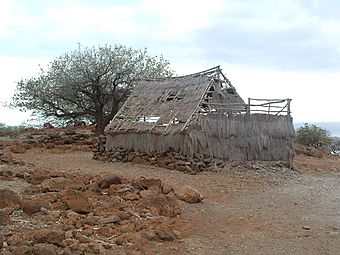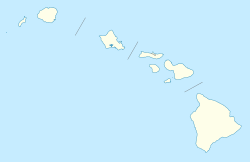Lapakahi State Historical Park facts for kids
Quick facts for kids |
|
|
Lapakahi Complex
|
|
 |
|
| Nearest city | Hawi, Hawaii |
|---|---|
| Area | 2,560 acres (1,040 ha) |
| Architectural style | Ancient Hawaiian |
| NRHP reference No. | 73000654 |
| Added to NRHP | July 2, 1973 |
Lapakahi State Historical Park is a special place on the Big Island of Hawaiʻi. It's located in the North Kohala District. This park protects the ruins of an Ancient Hawaiian fishing village. It's like stepping back in time to see how people lived long ago.
The name Lapakahi means "single ridge" in the Hawaiian Language. This name was used for an ancient land division called an ahupuaʻa. An ahupuaʻa stretched from the ocean all the way up to Kohala Mountain. The park is found off ʻAkoni Pule Highway (Route 270), about 12.4 miles (20 km) north of Kawaihae, Hawaii. It became a protected site on July 2, 1973.
Contents
What is Lapakahi State Historical Park?
Lapakahi State Historical Park is a large area that shows us how Hawaiians lived hundreds of years ago. It was once a busy fishing village. People here relied on the ocean for food and resources. The park helps us understand their daily lives, traditions, and connection to the land and sea.
A Glimpse into Ancient Hawaiian Life
Imagine a village where people lived off the land and the ocean. That's what Lapakahi was like. Villagers built their homes, fished, farmed, and practiced their culture here. They used tools made from stone, wood, and bone. They also had special places for religious ceremonies.
What You Can See Today
When you visit Lapakahi, you can walk through the village ruins. You'll see the stone foundations of old homes. There are also canoe sheds where fishing canoes were kept. You might spot ancient fishing shrines. These were places where people prayed for good fishing. There are also salt-making areas. Here, seawater was evaporated to get salt for preserving food.
You can also see reconstructed areas. These are parts of the village that have been rebuilt. This helps visitors imagine what the village looked like. It's a great way to learn about Hawaiian architecture. You can learn about how they built their homes and other structures.
The Marine Life Conservation District
Right offshore from Lapakahi is the Lapakahi Marine Life Conservation District. This is a protected ocean area. It's a safe home for many kinds of marine animals. Fish, corals, and other sea creatures live here. Protecting this area helps keep the ocean healthy. It also reminds us how important the ocean was to the ancient Hawaiians. They respected the ocean and its resources.
How to Visit Lapakahi
Lapakahi State Historical Park is open to visitors. It's a great place for a family trip. You can walk the trails and read signs that explain what you are seeing. It's a quiet and peaceful place. It offers a unique chance to learn about Hawaiian history. Remember to bring water and wear comfortable shoes.
Just north of the park is Māhukona Beach Park. This beach park is on a bay. Long ago, raw sugar from a local mill was shipped from here. It went all the way to San Francisco. This shows how important the coast was for trade and travel.


